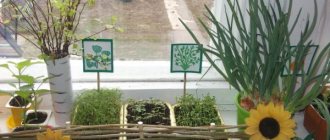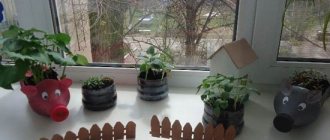Junior group. Early childhood, nursery. Children 1-4 years old
Individual lesson with a 4-year-old child with delayed psycho-speech development “Vegetable garden. Vegetables" Individual lesson with a 4-year-old child with delayed psycho-speech development " Vegetable garden . Vegetables"
.
Lexical topic: “Spring”
. Goal: to clarify and expand the child’s knowledge about vegetables, their name, appearance, and method of cultivation. Correctional, developmental and educational tasks: -…
Outline of a lesson on speech development “Vegetable garden” in an early age group Goals and objectives: to form an idea of vegetables and fruits, develop the ability to use them in speech, form an idea of where they grow, consolidate the concept of color, learn to classify vegetables and fruits; develop dialogical speech, memory, systematic thinking in...
Summary of the lesson “Child and Society” for the 2nd junior group Topic “To the rescue - to the garden”
September
Objectives: continue to form an idea about vegetables, where they grow (in the garden); expand children's active vocabulary through nouns (potatoes, carrots, cabbage, beets, turnips), verbs (bite off, chew, gnaw, swallow, pick, pull out, etc.); develop gross and fine motor skills; coordinate speech with movement, develop a sense of rhythm; cultivate a cognitive attitude towards the natural world.
Didactic material: a toy bunny, a bag made of bright fabric, a tray, dummies of vegetables or natural vegetables: potatoes, turnips, carrots, cucumbers and tomatoes, the “Vegetable Garden” manual, the “Basket” manual.
Progress of the lesson:
One, two, three, four, five - what will we buy?
One, two, three, four, five - (Walk in place.)
What will we buy?
Potatoes, carrots, (Clap your hands.)
Turnips and beets
Tomatoes, cucumber,
And finally cabbage!
Ask the children to remember what they bought with their mother at the grocery store and what all these fruits are called in one word. (Vegetables.) Invite the kids to sit on chairs.
What's in the bag?
Say that today you also went to the grocery store and bought various vegetables that you put in this bag.
Ask the children to try to guess what vegetables are there. To do this, ask the kids to take turns putting their hand into the bag, feel one of the vegetables there and name it. Only after this can the vegetable be removed from the bag and check the correctness of your answer. If the answer was correct, then the vegetable is placed on the tray, and if the child made a mistake, then the vegetable should be returned to the bag and the task should be completed again.
Various vegetables.
Ask the children to stand up and pretend to be different vegetables with you. Read rhymes and simultaneously perform various movements:
Look, a tomato - (Stretch your hands forward, round them and interlace your fingers.)
Thick, sugary,
Red and fleshy.
Smiled, (Smile.)
They took a bite, (Keeping a smile on your lips, open your mouth and then close it, clicking your teeth.)
Chewed, (“Chew” the wide tip of the tongue with your teeth - stick it out between your teeth and lightly bite your teeth several times, while pronouncing the syllables “ta-ta-ta.”)
Swallowed - “ah”! (Open your mouth wide and say “A-mm-mm.”)
Well, this is a turnip nearby - (Put your hands on your belt.)
Thick and strong (Puff up your cheeks.)
Round,
Yes sweetie. (Smack lips.)
Did you guys like it?
And now, like a bunny, deftly (Raise your upper lip, exposing your upper teeth and click your teeth at a fast pace.)
Nibble on a carrot.
Like this…
Zaikin's garden.
Show the children a toy bunny. Move him as if he is jumping. Say on behalf of the hare:
“Was someone here looking for me?
I came to you right away!
I'll call you guys
To help - go to the garden.
To collect everything in the garden beds,
I need people who are friendly to me.
Guys, a lot of vegetables have grown in my garden beds. I won’t be able to collect them alone, so I came to you for help. Can you help? Follow me".
Take the children to the chairs next to the easel. There is a manual “Vegetable Garden” on the easel. The bunny asks the children what vegetables are ripe in his garden. Children name: tomatoes, cucumbers, carrots, turnips, beets. The bunny explains to the children that cucumbers and tomatoes hang over the garden bed on branches - they will need to be picked, and beets, turnips and carrots grow directly from the ground. They need to be pulled out - pulled out of the ground.
Tell the children what you are going to do and then show them how to do it. Say the following phrases: “I will pick a tomato. I'll pick a cucumber. I'll pull out the carrot. I’ll pull out the turnip.”
Ask the children to help the bunny harvest. To do this, invite the kids one by one to the easel and ask which vegetable he wants to pick from a branch and which one to pull out of the ground. Let everyone speak first and then take appropriate actions. Place the collected vegetables in the “Basket” manual.
5. Tired!
Praise the children for collecting so many vegetables (show the Basket manual). Tell:
In the garden we tried - (Bend over.)
They bent low to the garden bed. (Straighten up and spread your arms to the sides with a wide gesture.)
All the harvest has been harvested.
Here he is. Bunny, get it! (Hang the basket on the bunny’s paw.)
Continue:
They were dragging beets from the ground - (Bend down and take turns making grasping movements with your hands.)
- Wow! Wow! Wow!
And a little tired - (Straighten up, put your palms on your lower back, turn your body in one direction or the other.)
- Oh! Oh! Oh!
Ask the children to listen carefully and model appropriate actions. Say interjections: “Wow! Wow! Wow! Oh! Oh! Oh! Wow! Wow! Wow! Wow! Wow! Wow! Oh! Oh! Oh!"
Then say goodbye to the bunny and invite him to turn to the children in kindergarten for help next time.



